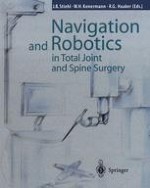2004 | OriginalPaper | Buchkapitel
Pedicle Screw Implantation Using the DISOS Template System
verfasst von : E. Schkommodau, N. Decker, U. Klapper, K. Birnbaum, H.-W. Staudte, K. Radermacher
Erschienen in: Navigation and Robotics in Total Joint and Spine Surgery
Verlag: Springer Berlin Heidelberg
Enthalten in: Professional Book Archive
Aktivieren Sie unsere intelligente Suche, um passende Fachinhalte oder Patente zu finden.
Wählen Sie Textabschnitte aus um mit Künstlicher Intelligenz passenden Patente zu finden. powered by
Markieren Sie Textabschnitte, um KI-gestützt weitere passende Inhalte zu finden. powered by
In computer-aided pedicle-screw implantation, exactly as in conventional procedures, correct positioning of the screw is only possible based on a precise knowledge of the anatomical structure in question. The choice of screw length and caliber depends to a great extent on detailed knowledge about this structure [6]. Generally, the greater the screw length and caliber, the better the anchoring [4]. In addition, particular attention must be paid to ventral boundaries and the constant danger of perforation in the area of the spinal cord. The proximity of the spinal column means the greatest care is required in introducing the screw in order to avoid damage to surrounding neural and vascular structures. Placement of a pedicle screw is therefore difficult since there is no direct view into the spine. In particular, problems can arise with medial or caudal placement of the screw, possibly resulting in serious neurological dysfunction. In the literature, faulty placements (perforations) using conventional procedures are reported to range from between 8.5% [2], 15.9% [9], 39.9% [3], and 42% [5].
